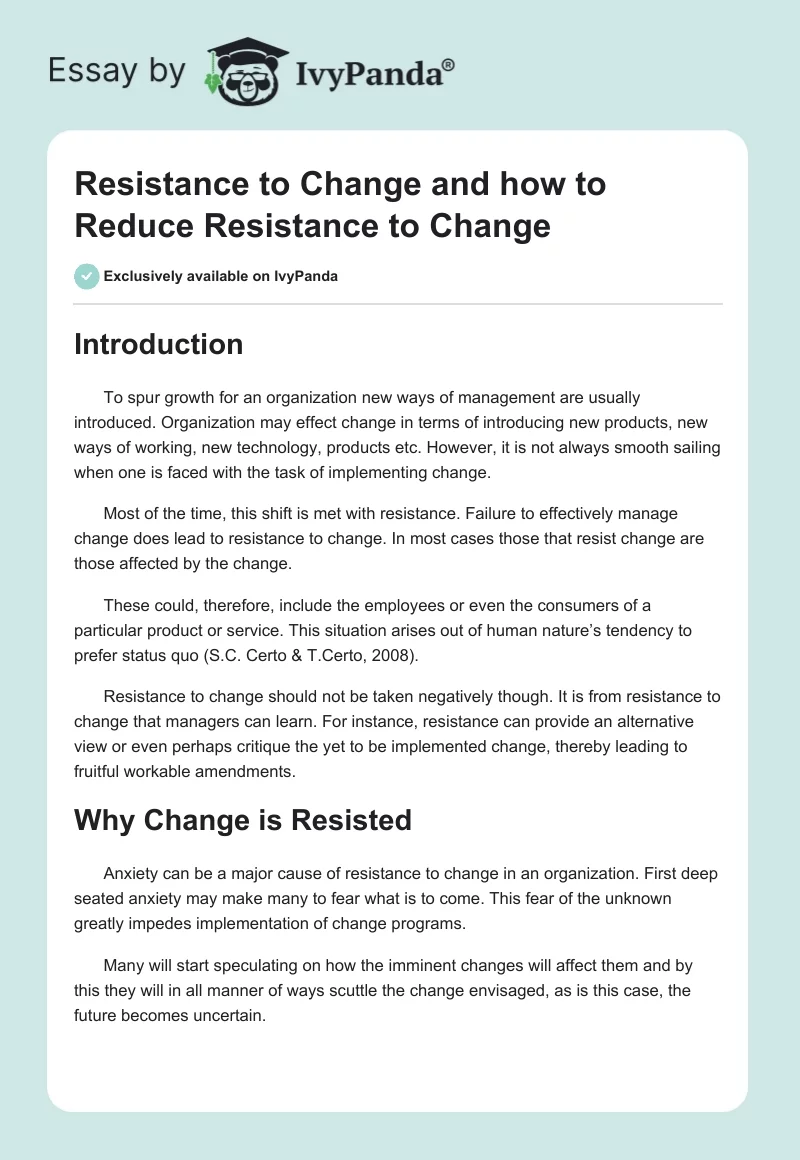Introduction
To spur growth for an organization new ways of management are usually introduced. Organization may effect change in terms of introducing new products, new ways of working, new technology, products etc. However, it is not always smooth sailing when one is faced with the task of implementing change.
Most of the time, this shift is met with resistance. Failure to effectively manage change does lead to resistance to change. In most cases those that resist change are those affected by the change.
These could, therefore, include the employees or even the consumers of a particular product or service. This situation arises out of human nature’s tendency to prefer status quo (S.C. Certo & T.Certo, 2008).
Resistance to change should not be taken negatively though. It is from resistance to change that managers can learn. For instance, resistance can provide an alternative view or even perhaps critique the yet to be implemented change, thereby leading to fruitful workable amendments.
Why Change is Resisted
Anxiety can be a major cause of resistance to change in an organization. First deep seated anxiety may make many to fear what is to come. This fear of the unknown greatly impedes implementation of change programs.
Many will start speculating on how the imminent changes will affect them and by this they will in all manner of ways scuttle the change envisaged, as is this case, the future becomes uncertain.
Another cause of resistance to change emanates from people’s self doubt. Many may fear that the new change would expose their weakness. The self doubt, therefore, stalks fear among people and by this; they will work to make sure that change is not effected.
For example, workers may have inherent feelings of inadequacy which they may fear the new change would expose. Through fear of failure to perform under the new change, they may develop a resistance to that particular change.
Again, once people get used to a particular way of doing things, they tend to develop comfort zones which they may be unwilling to vacate. So, when change is envisaged, many would prefer that the status quo remains.
To an extent, the way change is implemented or even conceptualized can lead to eventual resistance. Most managers craft policies that may bring change without involving the various cadres that will be affected by those changes.
Managing Resistance to Change
Achieving organizational change can be a daunting task for the manager. It is against this awakening that it is important for the manager to effectively reduce resistance to change. This is so because change in organizations is inevitable, in the ever evolving global stage.
One major way through which resistance to change occurs is through educating those who will be affected by the change. Sometimes people may resist because they do not fully understand the change and how it will affect them.
Thus, they need to be enlightened about the change and its benefits to them and the organization. According to S.C. Certo & T. Certo (2008), by educating the people, the manager will weed out unnecessary fear of the unknown and it will make those affected recognize how the change will benefit them and the organization.
Involving the people as early as possible in the change is crucial in reducing resistance. This is because they will feel part of the change process and so, they will not view the change as alien.
However, involvement should not just mean informing them, but it entails incorporating some of their sentiments in the change so that they may feel that they are part of the change process. Otherwise, many may feel as being just used as mere rubber-stamps.
Effectively communicating can greatly reduce the resistance to change. For example, where fears are expressed, it is important for the change managers to communicate every aspect that may cause worry.
Motivation can also prove as a sure way of making sure that resistance to that change is reduced considerably. It is crucial for the change agents to set out some motivation in the whole process.
For example, if it is introduction of new technology, the people affected should be told of how they will benefit from such exposure and many other things. Incentives could also be provided for those departments which will have fully complied at a certain stage etc.
Conclusion
Though resistance to change is always expected whenever a new way of doing things is planned, it is important to reduce resistance to change. Proactively involving the people who will be affected by the change will ensure that the whole process is fully understood and no unwarranted fear is allowed to sabotage the change being effected.
Reference List
Certo, S. C. & Certo, T. (2008). Modern Management: Concepts and skills. New Jersey: Prentice Hall.


